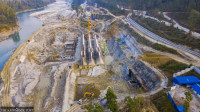Money
36th ACSIC conference concludes
The conference focused on green finance and promoting SMEs, a critical trigger for meeting globally committed investments in achieving the SDGs.
Post Report
The 36th Asian Credit Supplementation Institution Confederation (ACSIC) conference concluded here on Monday, focusing on green finance and promoting SMEs, a critical trigger for meeting globally committed investments in achieving the SDGs.
The 10th and final session participants discussed the 'Innovative Solutions: Financing for Nature’ theme.
Green finance is a new financial pattern integrating environmental protection and economic profits.
Babukaji Thapa, deputy general manager of the Agricultural Development Bank (ADB), emphasised how Nepal's banks and financial institutions promote green finance, mainly focusing on agriculture and forest-based enterprises.
According to him, ADB has been implementing three major projects related to green financing: Forest for Prosperity, Psychometric Prosperity, and Value Chain for Inclusive Agricultural Growth.
“These projects are being carried out in collaboration with various donor agencies,” he said.
Agriculture in Nepal is highly vulnerable to climate change. As a result, banks are hesitant to invest in forest-based and agriculture-related ventures.
Thapa said that banks and financial institutions seek collateral to access loans, but many small farmers cannot provide it. “Besides, the lack of financial literacy among farmers makes it difficult for them to navigate the loan process.”
“Nepal's forestry sector has a huge potential for economic growth. However, minimum investment and lack of favourable policy have hindered the realisation,” said Thapa.
Nepal's Central Bank has imposed a mandatory requirement to finance the agriculture and energy sector.
For example, commercial banks must provide at least 14 percent of their total credit to the agriculture sector by mid-July 2024 and 15 percent by mid-July 2025.
They must provide at least 8 percent of their total credit to the energy sector by mid-July 2024 and 10 percent by mid-July 2025.
Siddhant Pandey, CEO of Business Oxygen, IFC's SME Venture Fund, highlighted the innovative financial products currently implemented and practised in Nepal. He said that the growth in SMEs is transforming people's livelihoods in Nepal and has become a strong pillar in the national economy.
He underscored the need for a paradigm shift in investment by implementing blended finance tools. Blended finance tools mix public and private funds to reduce risk and help attract more investment in high-risk projects.
According to Pandey, blended finance is necessary because investors are more ready to take risks in such financing than investing in other tools.
He also said that the provision of Viability Gap Funding (VGF) in Nepal needs to be properly implemented. “As a result, Nepal has been failing to attract investors.”
He said Nepal should focus on green and resilient investment to achieve the SDGs and attain the zero carbon emission targets by 2045. He noted that renewable financing is complex in Nepal because investors are not assured of better returns. “Nepal needs some sort of policy intervention to promote green financing.”
Natasha Kapil, Lead Private Sector Specialist at the World Bank, underscored the need to boost SMEs. In technology, Kapil highlighted the need to adopt energy-efficient technology. “The SMEs are playing an important role in the national ecosystem,” she Kapil, adding that modern technologies could increase their productivity.




 20.02°C Kathmandu
20.02°C Kathmandu















